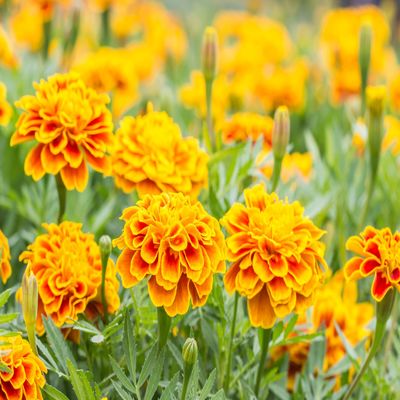
Marigold french gulzafri
 Gangagardens
Gangagardens
No annual is more cheerful or easier to grow than the marigold. These flowers are the spendthrifts among annuals, bringing a wealth of gold, copper, and brass into our summer and autumn gardens. The flower’s popularity probably derives in part from its ability to bloom brightly all summer long.Marigolds have daisy- or carnation-like flowerheads that are produced singly or in clusters.
Item Details
SKU
AVMFGSED36
How to plant marigold
French marigolds can easily be started from seed, while African marigolds are best purchased as young plants (when started from seed, they can take a long time to flower). Optional: If soil is nutrient-starved, add some slow-release (granular) fertilizer in the planting hole. A 5-10-5 works fine. Moisten the soil, then sow seeds 1 inch apart and no more than 1 inch deep. While still small, thin the seedlings. Space French and signet types 8 to 10 inches apart. The larger African marigolds should be at least 10 to 12 inches apart. If planting transplants, thoroughly water each plant after planting in the garden. If planting in containers, use a soil-based potting mix. Either mix in slow-acting granular fertilizer at planting time or plan to water with diluted liquid fertilizer periodically. Take care to space properly; marigolds grown in containers can become crowded.
Care
Once the marigolds have established themselves, pinch off the tops of the plants to encourage them to grow bushier. This will keep the plants from becoming leggy and will encourage more blooming. Marigolds don’t require deadheading, but if dying blossoms are regularly removed, it will encourage the plant to continue blooming profusely. When you water marigolds, allow the soil to dry somewhat between waterings, then water well and repeat the process. Water more in high heat. Do not water marigolds from overhead. Water at the base of the plant. (Excess water on leaves can lead to powdery mildew.) Do not fertilize marigolds during growth. A diet that’s too nitrogen-rich stimulates lush foliage at the expense of flowers. The dense, double flowerheads of the African marigolds tend to rot in wet weather. Add a layer of mulch between plants to suppress weeds and keep soil moist, especially when plants are young.
Pests/Diseases
Marigolds have few pests or problems overall, but spider mites and aphids sometimes infest the plants. Usually a spray of water or the application of an insecticidal soap, repeated every other day for a week or two, will solve the problem. Occasionally, marigolds will be affected by fungal diseases such as powdery mildew if conditions are too wet. To prevent fungal issues, avoid getting water on the marigolds’ leaves, keep weeds down, and plant in well-drained soil.
_-_Bulbs_(set_of_10)_2.webp)
_-_Bulbs_(set_of_10)_3.webp)